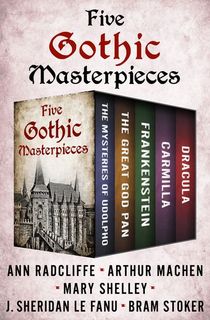Frankenstein author Mary Shelley—whose 222nd birthday is August 30th, 2019—lived a vibrant, controversial life nearly as dramatic as one of her books.
From falling in love and leaving home at age 16 to writing one of the most influential sci-fi novels ever, Shelley defied expectations for the women of her time. Just as her work continues to compel readers, her life continues to fascinate as well—so much so that a 2018 film even focused on her tempestuous private life and the struggles she faced as a female writer in the early 19th century.
Below are 15 fascinating facts about Frankenstein author Mary Shelley.
She came from a family of intellectuals

Mary Wollstonecraft
Photo Credit: Wikimedia CommonsMary was born into a family of thinkers. Her mother, Mary Wollstonecraft—who died less than a month after her daughter was born—was one of history’s first feminist writers. Wollstonecraft was a prominent revolutionary voice pushing for social reform; her 1792 text A Vindication of the Rights of Woman argues for women's education and equality of the genders.
Mary Shelley's father, William Godwin, was a philosopher—one Mary’s future husband would admire greatly. Godwin was considered controversial both for his radical, anarchist views, and for the biography he wrote of his wife after her death from childbirth complications.
RELATED: J.R.R. Tolkien: 15 Interesting Facts About the Man Behind Middle-earth
Mary may have made love on her mother's grave
Mary spent a lot of time at her mother's grave in the cemetery of St. Pancras Old Church in London, and is said to have learned the alphabet by tracing the letters on the gravestone.
Charlotte Gordon, author of Romantic Outlaws: The Extraordinary Lives of Mary Wollstonecraft and Her Daughter Mary Shelley, says Shelley learned more than just letters at the gravesite: she also confessed her love to her future husband, Percy Shelley, while the two visited her mother's grave.
According to Gordon, "That’s where we think she had sex for the first time, on her mother’s grave. We can’t prove that they actually had sex, but they certainly declared their love and became intimate. It was a really dangerous thing to do."
RELATED: Who Is H.G. Wells? Exploring the Sci-Fi Legacy of The Time Machine Author

Gravestones in the cemetery at St. Pancras Old Church.
Photo Credit: Wikimedia CommonsHer father disowned her ... but might have committed murder on her behalf
At 16, Mary met her future husband, 21-year-old Percy Bysshe Shelley, who was then working as an apprentice to her father. The two took to each other quickly, and ran away together to Paris. At the time, Shelley was already married, and consequently Mary's father disowned her.
However angry Mary’s father may have been, some believe he may have committed murder to save her reputation. In 1816, two years after Shelley and Mary first ran away together, Shelley's pregnant wife Harriet Westbrook (who was going by the last name 'Smith' at the time) was found dead in a Hyde Park river.

Percy Bysshe Shelley.
Photo Credit: Wikimedia CommonsOfficially, her death was ruled a suicide by drowning, but stories that Godwin murdered her to protect his daughter’s name never ceased. Mary and Shelley married at Godwin's suggestion mere weeks after Harriet was found dead, thereby making their relationship legitimate and easing the estrangement between Mary and her family. Some believe Shelley may have even been responsible for the death of his first wife.
However, there's no evidence that Harriet's death was anything but a suicide. The coroner handling the case issued a statement clarifying that “Harriet Smith had no marks of violence appearing on her body."
RELATED: 9 Little-Known Facts About Jules Verne
Mary felt great grief and guilt throughout her life over Harriet's sad fate. In an 1839 journal entry, Mary wrote that she believed "so many of my own heavy sorrows as the atonement claimed by fate for her death.”
Mary was only 18 when she wrote Frankenstein
Late one night while Mary, Shelley, Lord Byron, and Byron’s close friend John Polidori were stranded by a storm in their villa in Geneva, Switzerland, Byron challenged the group to write a horror story. Mary started writing the story that would evolve into Frankenstein.
Related: 13 Classic Science Fiction Books Everyone Should Read
Frankenstein isn’t the monster, but rather the doctor who created him
A common misconception that was popularized over the years was the name of the creature. “Frankenstein” is actually the name of the doctor in Mary Shelley's novel, Victor Frankenstein, not the reanimated being he performs experiments on. Throughout the novel, Shelley doesn’t attribute a title or pseudonym to the creature, so in reality, it really doesn’t have a name at all.
Dr. Frankenstein came to her in a dream
Shortly after the writing challenge was first proposed, Mary said she had a nightmare that helped her flesh out the concept behind Frankenstein.
In a preface to the novel written for the third edition, she wrote that she "saw—with shut eyes, but acute mental vision [...] the pale student of unhallowed arts kneeling beside the thing he had put together."
The creature also isn’t green, and doesn’t have plugs sticking out of his neck

Illustration of the monster in the 1831 edition of the novel.
Photo Credit: Wikimedia CommonsYet another common misconception about Frankenstein is the physical appearance of Mary Shelley’s monster. In the novel, the monster is an eight-foot tall human-like creature with grotesque features. Shelley describes the creature in the following paragraph:
“His limbs were in proportion, and I had selected his features as beautiful. Beautiful! Great God! His yellow skin scarcely covered the work of muscles and arteries beneath; his hair was of a lustrous black, and flowing; his teeth of a pearly whiteness; but these luxuriances only formed a more horrid contrast with his watery eyes, that seemed almost of the same colour as the dun-white sockets in which they were set, his shrivelled complexion and straight black lips.”
The reason why the monster’s iconic look involved plugs and green skin was due to Boris Karloff’s portrayal of the creature in the 1931 film adaptation of the novel. The creature in the film had plugs coming out of his neck and had a hard hairline with stitches. The green skin was later introduced in 1964 in an issue of Mad Magazine where the creature was depicted with pale-emerald skin.
Related: 8 Scary Creatures from Sci-Fi Books
After mixing these two elements, we get the bright green, spark plug monstrosity that most people are familiar with today. Although hideous to look at, the creature is actually a sensitive soul with an affinity for philosophy and reason. However, because of his physical appearance, the creature is shunned and feared by society.
Mary Shelley may have had a personal connection to corpse reanimation
Reanimation was a surprisingly popular subject in the early nineteenth century, and Mary's own life was heavily influenced by the then-controversial practice of resuscitation.
Resuscitation was heavily endorsed by the Society for the Recovery of Persons Apparently Drowned (now called The Royal Humane Society), an organization founded in 1774 to decrease drownings in London. When Mary's mother attempted suicide by jumping into the Thames River, it's believed she was revived using practices endorsed by the Society.
Some saw the practice of resuscitation as unnatural, or, as Wollstonecraft herself called it, other than human: '‘I have only to lament, that, when the bitterness of death was past, I was inhumanly brought back to life and misery." The Society also organized an annual procession of those who had appeared dead but were revived via resuscitation—a somewhat grim celebration.

The procession of the 'undead' marches through a Royal Humane Society banquet.
Photo Credit: Wikimedia CommonsGiven this personal connection to a drowning victim who was resuscitated, it's not surprising that Mary had a strong interest in the boundary between life and death, which for Londoners at this time seemed particularly blurry.
She was first published in 1807
While Frankenstein is what Mary is most known for, it was not her only piece of writing that was published. She went on to write other sci-fi stories including her 1826 short story Roger Dodsworth: The Reanimated Englishman about a man frozen in ice, and The Last Man, about a man alone in the world after surviving a plague that wiped out the rest of the human race.
She was published for the first time in 1807, when her poem Mounseer Nongtongpaw was published through the children's imprint Juvenile Library with the help of her father.
Mary didn’t put her name on the first publication of Frankenstein
Most likely a result of the time in which she was writing, and the controversial content of her story, Mary first published Frankenstein under “anonymous.” Frankenstein, or The Modern Prometheus, was published in 1818, but didn’t have Mary’s name on it until 1831—because of this, many at first assumed her husband Percy Shelley wrote it.
Frankenstein wasn’t received well by critics upon its publication
Despite being a literary classic, Mary Shelley’s Frankenstein wasn’t an immediate hit when it was published. After the story began to circulate throughout the country, critics who read through the text were astonished by the grotesque details and morbid storyline. One review at The Quarterly described the novel as “a tissue of horrible and disgusting absurdity” in 1818. Needless to say, future generations saw the beauty in Shelley’s terrifying tale.
She might have drawn inspiration from the real-life Frankenstein castle
Mary Shelley's novel has the same name as Frankenstein Castle in Germany, in which real-life alchemist Johann Conrad Dippel was rumored to have experimented with human and animal parts.
Because of the castle's name and the apparent similarities between Dippel and the fictional Dr. Frankenstein, some say Mary must have learned of the castle during an 1814 trip to Germany in which she briefly visited a town close to the castle. However, there's no mention of the castle in her journals.
RELATED: The Creepy Story of the Real-Life Frankenstein Castle
Tragedies plagued her life
Mary's life was marked by death and disaster. Her mother died from complications of childbirth just a few weeks after Mary was born. Fanny, Mary’s half-sister, committed suicide when Mary was in her teens. Her first son with Shelley died 12 days after birth and her second son died when he was three years old; only one of her four children survived to adulthood. Her husband Percy Shelley drowned in the Mediterranean Sea in 1822. Two years later, Mary and Shelley’s closest friend, the poet Lord Byron, died.
These deaths eventually took a major toll on Mary, forcing her into a severe depression. Mary herself died from a brain tumor when she was 53.
Mary Shelley wrote different versions of Frankenstein

Victor Frankenstein in a 1910 film adaptation.
Photo Credit: Edison Manufacturing CompanyBefore settling on the Frankenstein we all know and love today, Mary Shelley actually had several variations of the story. Like any good author, Shelley went through multiple revisions, many of which portrayed Dr. Frankenstein differently.
Related: Fun Facts About 9 Great Science Fiction Authors
Originally, the doctor was written as a man of free will who suffered the consequences of his own actions. However, after the death of her children, Shelley realized that not all tragedies are due to human actions. Because of this experience, Shelley changed her mind about the character, and wanted to make Dr. Frankenstein a victim of fate. In turn, this helped flesh out some of the story’s major themes.
She is said to have carried her late husband's heart around with her
Following Shelley's death from drowning at age 29, his remains were buried in a Roman Protestant cemetery. But Mary held onto his heart, protecting it in a silken shroud. A year after she passed away, the heart was found in her desk, wrapped in the pages of Shelley's poem Adonais.
[Via Mental Floss, The Frankenstein Diaries, HeadStuff, Alcor Life Extension Foundation, Huffington Post]
Featured photo: Wikimedia Commons



